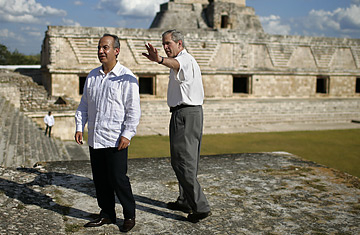
President Bush and Mexican President Felipe Calderon tour the Nunnery Quadrangle at the Mexican Mayan ruins in Uxmal, Mexico, March 13, 2007.
But then the President would seem to catch himself, count to 10 and concede that Latin Americans did have some legitimate gripes about things like "social justice" and that the U.S. could do more to address them. As a result, while Bush's trip south of the border wasn't exactly a triumph, it wasn't exactly a failure either. More important, it showcased Latin America as a sort of testing ground for the Bush Administration's new "reality-based" foreign policy — a willingness to acknowledge that diplomacy can be more effective than domination, and that even in weaker regions like Latin America we still have to carry bargaining chips if we want the locals to aid U.S. interests like the drug war, immigration control and free trade.
If there was one thing that hinted at the potential success of that strategy, it was the fevered reaction of the de facto leader of Latin America's resurgent left, Venezuelan President Hugo Chavez. For years, the Administration has been falling into Chavez's traps — usually by taking the bait whenever he goes into one of his intemperate anti-Bush tirades: Chavez calls Bush a "donkey," the Administration calls Chavez a menace, Chavez's poll numbers rise. But this time Chavez looked a bit like the dupe: rather than ignoring Bush's fence-mending foray, Chavez frantically crisscrossed the continent, heckling him and warning his Latin brethren not to listen to Bush — as if Chavez might be genuinely concerned that the U.S.'s new diplomatic tone could pick up a few hearts and minds.
But for the moment, a few is all the U.S. is picking up. That was uncomfortably apparent in Mexico, home to a conservative new President, Felipe Calderon, whom Bush was counting on for his warmest reception. What he got instead was a tense tour finale. Bush apparently hadn't read many of Calderon's remarks in the months and weeks leading up to their Yucatan summit this week — such as his comparing a Bush-approved, 700-mile-long border fence to the Berlin Wall, or calling the illegal immigration issue an "open wound" for U.S.-Mexico relations. Calderon defeated his own left-wing opponent last summer by only half a percentage point, and few countries feel more resentful about Bush's recent snubbing of Latin America than Mexico does. So while Bush rightly considers the free market-minded Calderon his "anti-Chavez" in the region, Calderon knew he could score points with Mexicans who voted against him by publicly chastising Bush this week on matters like Washington's nagging failure to adopt immigration reform.
In other words, it was a lesson for Bush in Latin American politics as well as general international affairs. And it was straight out of the textbook he had angrily shut five years ago — but which, to the gratification of many Latin Americans, he finally seems to have cracked again.
